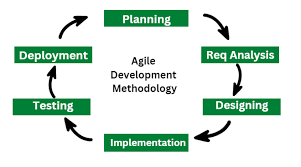Agile Development Overview
Agile development is a software development methodology that emphasizes flexibility, collaboration, and customer satisfaction. It focuses on delivering small, incremental releases of software that can be quickly adapted to changing requirements.
The Agile approach values individuals and interactions over processes and tools, working software over comprehensive documentation, customer collaboration over contract negotiation, and responding to change over following a plan.
Key principles of Agile development include:
- Iterative Development: Software is developed in small increments or iterations, allowing for quick feedback and adaptation.
- Collaborative Approach: Cross-functional teams work closely together and with stakeholders to deliver value.
- Adaptive Planning: Plans are flexible and can be adjusted based on changing requirements or feedback.
- Continuous Improvement: Teams regularly reflect on their processes and seek ways to improve efficiency and effectiveness.
Popular Agile methodologies include Scrum, Kanban, Extreme Programming (XP), and Lean Software Development. These frameworks provide guidelines for implementing Agile principles in practice.
In conclusion, Agile development offers a flexible and collaborative approach to software development that prioritizes customer satisfaction and responsiveness to change. By embracing Agile principles and methodologies, teams can deliver high-quality software products that meet evolving business needs.
5 Key Tips for Mastering Agile Development: Flexibility, Collaboration, and Customer Focus
- Embrace change and be flexible in responding to it.
- Prioritize collaboration and communication within the team.
- Deliver working software frequently, in short iterations.
- Focus on customer satisfaction by delivering valuable software.
- Regularly reflect on how to become more effective, and adjust accordingly.
Embrace change and be flexible in responding to it.
In Agile development, it is crucial to embrace change and be flexible in responding to it. By welcoming change as a natural and inevitable part of the development process, teams can adapt quickly to evolving requirements and market conditions. Being open to change allows for continuous improvement and ensures that the final product meets the needs of customers effectively. Flexibility in responding to change enables Agile teams to deliver value efficiently and stay ahead in today’s dynamic business landscape.
Prioritize collaboration and communication within the team.
In Agile development, prioritizing collaboration and communication within the team is essential for success. By fostering open communication channels and encouraging teamwork, team members can share ideas, provide feedback, and work together towards a common goal. Effective collaboration ensures that everyone is on the same page, minimizes misunderstandings, and promotes a sense of ownership and accountability among team members. Ultimately, strong collaboration and communication lead to better decision-making, increased productivity, and the successful delivery of high-quality software products.
Deliver working software frequently, in short iterations.
In Agile development, a key tip is to deliver working software frequently, in short iterations. By breaking down the development process into manageable chunks and releasing functional software at regular intervals, teams can quickly gather feedback, make necessary adjustments, and ensure that the final product meets customer requirements. This iterative approach not only accelerates the delivery of value to stakeholders but also promotes transparency, collaboration, and continuous improvement within the development team.
Focus on customer satisfaction by delivering valuable software.
In Agile development, a key tip is to prioritize customer satisfaction by focusing on delivering valuable software. By understanding and meeting the needs of the end users, teams can ensure that the software they develop adds real value and addresses specific pain points. This customer-centric approach not only enhances user experience but also fosters trust and loyalty, ultimately leading to successful outcomes for both the customers and the development team.
Regularly reflect on how to become more effective, and adjust accordingly.
In Agile development, it is crucial to regularly reflect on how to become more effective and adjust accordingly. By taking the time to assess processes, communication, and team dynamics, teams can identify areas for improvement and make necessary adjustments to enhance productivity and efficiency. This continuous reflection and adaptation not only foster a culture of learning and growth but also ensure that teams are constantly striving to deliver better results and meet evolving project requirements in a more effective manner.




